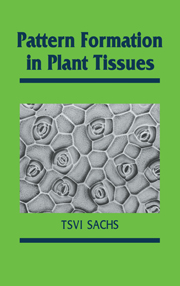Book contents
- Frontmatter
- Contents
- Preface
- 1 Introduction
- 2 Interactions of developing organs
- 3 Hormones as correlative agents
- 4 Callus and tumor development
- 5 The polarization of tissues
- 6 The canalization of vascular differentiation
- 7 Cell lineages
- 8 Stomata as an example of meristemoid development
- 9 Expressions of cellular interactions
- 10 Apical meristems
- 11 The localization of new leaves
- 12 A temporal control of apical differentiation
- 13 Generalizations about tissue patterning
- References
- Author Index
- Subject Index
13 - Generalizations about tissue patterning
Published online by Cambridge University Press: 05 October 2009
- Frontmatter
- Contents
- Preface
- 1 Introduction
- 2 Interactions of developing organs
- 3 Hormones as correlative agents
- 4 Callus and tumor development
- 5 The polarization of tissues
- 6 The canalization of vascular differentiation
- 7 Cell lineages
- 8 Stomata as an example of meristemoid development
- 9 Expressions of cellular interactions
- 10 Apical meristems
- 11 The localization of new leaves
- 12 A temporal control of apical differentiation
- 13 Generalizations about tissue patterning
- References
- Author Index
- Subject Index
Summary
CONTROLS OF CELLULAR DIFFERENTIATION
Tissue patterning is an orderly, controlled expression of various potentials for cellular growth and differentiation. It is often assumed, or at least implied, that the capacity of plant cells to differentiate is unlimited and that each event is specified by the precise conditions the cells are in at some critical, early period of their development. This dogma is certainly not borne out by the discussions above, and an alternative set of generalizations is required. Thus, before the patterning processes that were arrived at in the previous chapters are summarized and discussed it is necessary to consider what developmental alternatives are available to plant cells and what determines their expression.
Totipotentiatility and limited developmental alternatives
Organized development, like other major functions of a plant, is limited to special tissues. The cells of these developing tissues are of distinct, differentiated types: they have unique characteristics and undergo only limited developmental changes, even in experimental conditions (Chapter 10). Furthermore, it is not just development but also its various component processes that are performed by cells of different specialization. Organogenesis occurs only in promeristematic, or embryonic, regions – in small cells with a dense cytoplasm, no obvious polarity, and slow growth. Most increase in volume or growth occurs in primary meristems where development is rapid, polarized and generally of limited duration. Cambia, whose cells differ from those of promeristems, are responsible for increase in diameter.
- Type
- Chapter
- Information
- Pattern Formation in Plant Tissues , pp. 179 - 197Publisher: Cambridge University PressPrint publication year: 1991

